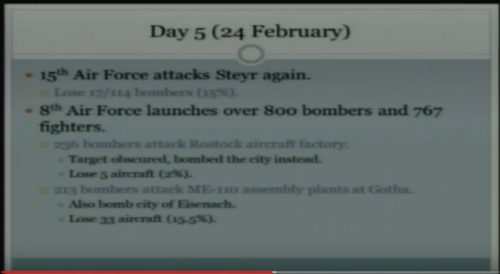
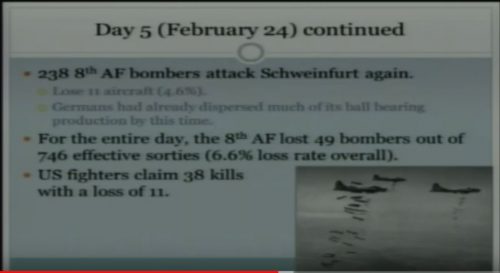
Missions 237, 238 and 239 are flown against targets in France; 7 B-17s are lost. Heavy clouds cause over half the bombers dispatched to return without bombing..Mission 237: 49 of 81 B-24s hit the Ecalles sur Buchy V-weapon sites; 1 B-24 is damaged. Escort is provided by 61 P-47s.Mission 238: 258 B-17s are dispatched against V-weapon sites in the Pas de Calais; 109 hit the primary target, 10 hit a road junction E of Yerville, 7 hit a rail siding SW of Abbeville and 6 hit targets of opportunity; 7 B-17s are lost and 75 damaged; casualties are 5 WIA and 63 MIA. Escort is provided by 81 P-38s, 94 P-47s and 22 P-51s; 1 P-38 is damaged beyond repair; the P-51s claim a single German aircraft on the ground..Mission 239: 5 of 5 B-17s drop 250 bundles of leaflets[clarification needed] on Amiens, Rennes, Paris, Rouen and Le Mans, France at 20232055 hours without loss.
Bomber Command directly contributed to the attacks on the aircraft industry in Schweinfurt. Some 734 bombers were dispatched on the night of 24/25 February, and 695 struck the target.[1] Of the bombs dropped, 298 hit within three miles and 22 hit inside the target area. Little damage was done.
.
For extensive background, see this Wikipedia article, where the passage above came from:
In July, when a bomber group took over Horsham Saint Faith, Zemke’s men relocated to a half-built base at Halesworth Suffolk. Upset with the second-rate treatment his command seemed to be experiencing, Zemke joined a group of Eighth Air Force bomber commanders in a gripe session. The 4th Bomb Wing’s Colonel Curtis LeMay (chief of the postwar Strategic Air Command) complained that the only fighters he had seen so far ‘all had black and white crosses on them,’ but declared his bombers would carry on ‘with or without fighter escort.’
.
Later, in the officers’ club, another bomber general stated he ‘wouldn’t pay a dime a dozen for any fighter pilots.’ Zemke hurled his pocket change at the man’s feet:
.
‘Here, General, this is all I have handy at the moment,’ he responded. ‘Any time you have a couple dozen fighter pilots handy send them my way. We can sure use them.’ Then he jumped in his Jug and buzzed the place.
By now the Wolfpack, flying out of Boxted, Essexand accounting for more than 400 killshad developed P-47 tactics to a high art, diving to the attack and zooming back up to safety. From that strategy evolved group tactics: a lead squadron flying low, covered by the second at medium altitude, with the third high up in reserve. Spreading out ahead of the bombers to sweep the skies clean of German fightersthe ‘Zemke Fan’ the 66th Fighter Group presented an awesome array of aerial firepower..
Zemke was important in helping turn the tide of the air war in Europe by espousing tactics that allowed U.S. fighters to break from close escort and attack enemy planes before they could get to the bombers, known as the “Zemke Fan”, in which fighters rendezvoused at a prominent landmark in their escort zone while flying ahead of the bomber formations, then with the elements of fighters scattering and fanning out by flights in a 180 ° arc.[1] The Eighth Air Force as a whole adopted a modified “Zemke Fan” in early 1945 for all its groups.
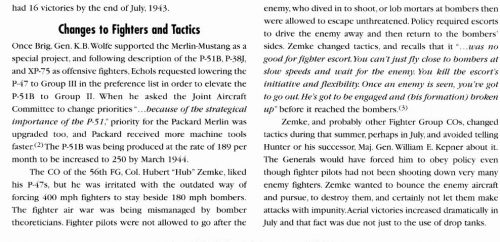
.
There was a whole lot of signals operational technique to make the three shift fighter escort doctrine the 8th AF used in “Big Week” to work. How the VIIIth Fighter Command got its fighters to the bomber stream was a hugely important element in this story and it has not been told outside a few modern RAF signals intelligence histories.
.
And in particular, before that three shift doctrine was officially implemented, small groups of P-47 fighter pilots in the 56th Fighter Group broke away consistently in the Fall-winter of 1943 from the 8th Air Force bomber streams they were supposed to be a “close escort” in order to break up and dogfight with Luftwaffe forces at build up points over German radio-visual beacons.
.
This was in the period where General Eaker had orders that American fighters stick close to the bomber stream. It amounted to an organized conspiracy to commit systematic desertion of their assigned posts by the 56th Fighter Group in the heat of combat…in so many words “Mutiny at 30,000 feet.”
.
…The Eighth Air Force also exploited Y intelligence operationally, during actual missions, just as the RAF had done during the Battle of Britain and thereafter. Activated in July 1943, the Kingsdown HookUp was the means to produce and disseminate near-real-time intelligence from voice intercepts to the American pilots of the VIII Fighter Command as they flew escort missions and fighter sweeps. RAF Kingsdown was the centre of a network of voice intercept stations in the United Kingdom, known by their cover name, ‘Home Defence Units’ (HDU). External telephone lines connected Kingsdown to the HDUs, the Air Section at GC&CS, and other parties, and internal telephone lines allowed intelligence officers to discuss and evaluate voice intercepts and D/F bearings being telephoned to Kingsdown. The officers identified significant operational combat intelligence which they telephoned to the fighter control room of AJAX, the headquarters of the VIII Fighter Command, which in turn passed it to the control centres of the commands’ three fighter wings. A second telephone line linking AJAX and Kingsdown enabled the signal intelligence officer at AJAX to discuss and clarify intelligence flowing over the first line. Two hours before each mission, the VIII Fighter Command would brief the officers at Kingsdown the route, timing, and targets of the impending mission.28 During operations the Kingsdown Hook-Up provided information about the American bombers as they flew beyond the range of British based radar. Y intelligence informed American fighter controllers not only where German fighters were assembling but where American formations were located. If bombers withdrew off course, the controllers would vector fighters to reposition themselves to provide cover for the wayward formations. As longer-range fighter escort became available, the Kingsdown Hook-Up increased in value as wing controllers, operating on Y intelligence, vectored pilots to enemy fighter assembly areas to engage the GAF pilots far from the bombers and to disrupt the enemy’s plan and sequence of attack. The Kingsdown Hook-Up was fully operational during Big Week, 20-25 February 1944, when the Eighth and Fifteenth Air Forces pounded the German fighter aircraft industry by day, and the RAF struck related target areas at night. By the end of March 1944 GAF units had retreated to air bases farther from the coast which drastically curtailed the number of voice intercepts heard by the HDUs in the United Kingdom.
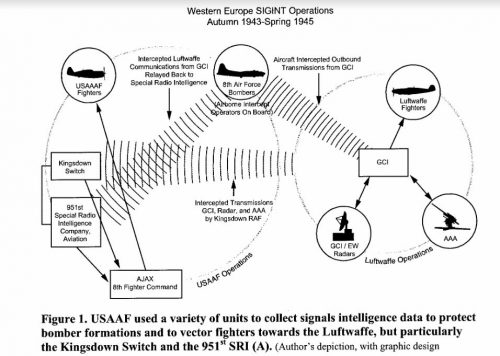
.
One of the duties of the RAF Y-Service in the UK was to plot through direction finding (D/F) the physical location of Luftwaffe radio beacons and identify the associated code words as German pilots reported to various beacons in order to assemble fighter formations for attacking Allied bombers.
.
This meant the Kingsdown Switch Hook Up service had a ring side seat for SchweinfurtRegensburg mission. This mission was the first where the Luftwaffe put together the complete, coordinated, aerial combined arms team of rocket firing twin engine heavy fighter (ME-110) and lighter single engine Me-109/FW190 large formation attacks that could destroy any heavy bomber combat box formation, no matter the size, that lacked fighter escorts through out the entire mission.
.
That the 56th Fighter Group used the Kingsdown Switch Hook Up service in this mission is beyond dispute. The fact was in the days before uniform aerial fighter radar fighter planes had to be directed within 5-miles (8-km) and a 5,000 foot altitude band for a successful visual intercept on a clear day. Germany was an area the size of the US state of Texas and 8th Air Force bombers flew over 20,000 feet altitude. Expecting Allied fighters to find and destroy large numbers of German fighters on the way to a bomber stream rendezvous without outside electronic queuing amounts to believing six impossible things before breakfast. And to cover the return leg of the SchweinfurtRegensburg mission, outside direction had to drop Zemke’s Wolfpack upon a German twin engine fighter assembly point it destroyed (again via www.historynet.com) :
.
The bomber crews had good reason to be edgy. They were about to depart on one of their bloodiest missions, the first Schweinfurt-Regensburg raid. After escorting the B-17s part way to Schweinfurt, the 56th returned to Halesworth and took on 200-gallon, pressed-paper ferry tanks converted for combat use. These upset the Jugs’ handling and did not feed well in the low air pressure above 20,000 feet, but they gave the Thunderbolts enough range to meet the bombers over Germany.
.
The Thunderbolts proceeded to teach a Staffel of twin-engine Messerschmitt Bf-110 night fighters (Me-110s to American fighter pilots) not to venture out in daylight. ‘The 61st Squadron came screaming down from the front and caught an Me-110 right over the last box of bombers,’ Zemke recalled. ‘Two P-47s shot at this guy at the same timesixteen guns firingand both of them hit him simultaneously. That Me-110 blew up as I’ve never seen anything blow up and fell, on fire, directly through the bomber formation…without hitting one of them.’
.
One of the Bf-110 shooters was Jerry Johnson, who downed two more Germans in quick successionthe 56th‘s first triple kill, except that he had to split credit for the Messerschmitt. (Two days later, Johnson got a Bf-109, which could have made him the 56th‘s first ace. Instead, his score stood at 4 1/2.)
.
Zemke, having gotten a Bf-110 himself, estimated the combat at no more than seven minutes long, but at that distance from base, fuel was already running low and he ordered a return home. From well to the north, however, Captain Bud Mahurin called back, ‘We’ve got ’em cornered. There’s plenty for everyone. Come on up this way.’
.
Soon after Zemke’s run-in with Bomber Command, Mahurin had gotten a little too close to one of the new Consolidated B-24 Liberators in formation and his Thunderbolt’s tail had been sucked into the bomber’s props; the four-engine B-24 had straggled home, but Mahurin had barely escaped from his falling Jug. Now he saw his chance to make amendshe had spotted a Focke-Wulf above the bombers, preparing to turn down into them. Mahurin recalled, ‘I sneaked up behind it and started to fire from about 300 yards, closing to 200 yards. It blew up.’
.
Mahurin and his wingman circled up through the bomber stream onto the tail of a second Fw-190. ‘We followed him until he started to make a turn into the front end of the bombers,’ said Mahurin, ‘when I took a deflection [angled] shot at him and watched him blow up.’
.
Not one to hold a grudge, Zemke recommended Mahurin for the Distinguished Flying Cross. Later it turned out one of his kills was none other than the commander of II Gruppe JG 26, Oberstleutnant (Lt. Col.) Wilhelm ‘Wutz’ Galland, brother of the famous Luftwaffe General of Fighters Adolf Galland and himself a 55-victory Experte (ace). His body was found in his aircraft two months later, driven by the force of impact 12 feet into the ground.
.
I spent a fair amount of time trying to find that man. By rank he could not be either a flag officer or a senior flight rated pilot. It had to be a signals officer of about colonel rank and Zemke’s success in spreading this mutiny meant that -somebody- had to take the hit for the Bomber General’s frustration with the wide spread organized and ultimately successful fighter pilot disobedience.
.
Thomas Alexander Hughes’ book “OVERLORD: General Pete Quesada and the Triumph of Tactical Air Power in WW2″ on pages 132-133 seems to have given me that man, a Colonel that got kicked out of 8th AF signals section before D-Day and who was picked up by the fighter pilot General Quesada for his IXth Tactical Air Command (TAC). His name was Col. Blair Garland. And the Quesada book gives the timing of Garland’s firing that fits my theory.
.
Col Garland was in the right place. Then fired and re-hired by Quesada at the right time, to be the man at AJAX that supported “Mutiny at 30,000 Feet.”
.
P-47— The 56th Group, equipped with P-47s, claim that, while the P-51 may have certain advantages, notably in range, the P-47 is much sturdier, can pull out sharper from dives, can absorb more punishment, and is a better all-around plane for strafing. They have taken some of the P-47s and modified them on the spot to what they call “Superbolts”. This is the standard P-47 with water injection, paddle propellers, two guns removed, IFF equipment removed, and front armor plate taken out. This reduces the weight by 840 pounds and under military h.p. it will outclimb and outperform anything in the theater. The 56th generally uses four of these planes for top cover. Their specific suggestions are as follows:
.
(a) In the future models of the P-47 retain the eight guns by all means.
(b) Supply them as early as possible with A-23 modified turbo regulators. They are having difficulty with the present ones.
(c) They are very short on Hamilton propeller spares. On ground strafing the front end of the plane is taking quite a beating.
(d) They need rear vision mirrors of the latest improved type.
(e) At the present time their range is limited by their oil capacity. The oil tank theoretically has a 27 gallon capacity but because of the altitude work the maximum they can carry is 19 gallons. The average P-47-25 burns about 13 quarts an hour with the maximum allowable of 22 quarts. Brand new planes burn about 6 quarts an hour but the average plane with 150 hours runs about 13 quarts, or a 4 hour limit in range at that oil consumption.
Abnormal oil consumption in the recent past was, they feel, the result of an improper grade of oil supplied them in England. However, even with the proper grade of oil the engineering officers state that there is from an hour to an hour and a half more range on their gasoline tank than there is on oil
(f) They state that in order to accomplish their missions they have to run at the absolute maximum automatic lean mixture. They feel, therefore, that in any gasoline the lean side for cruising range is at least as important as the rich mixture quality of the gasoline.
.
NARA II
|
ADDRESS REPLY TO
COMMANDING GENERAL, ARMY AIR FORCES
WASHINGTON 25, D. C.
(AFDMA-2A)
HEADQUARTERS, ARMY AIR FORCES
Washington
6 July 1944
SUBJECT: Information on P-51, P-47 and P-38.
TO: Commanding General,
Materiel Command
Wright Field, Dayton, Ohio
Attn: Chief, Engineering Division
1. Inclosed is a copy of a memorandum for General Echols from Mr. Lovett, dated 3 July 1944, subject: “Fighter Aircraft with VIII and IX Air Forces”, in which inquiries are made concerning subject airplanes.
2. Comments and recommendations “by the Engineering Division on Mr. Lovett’s letter are requested, by July 13.
By Command of General ARNOLD:
/S/
R. C. WILSON
Colonel, Air Corps
Chief, Devel. Engr. Br., Materiel Div.
Office, Asst. Chief of Air Staff
Materiel, Maintenance & Distribution
Incl.
cy Memo fr Mr. Lovett dtd 3 July 44.
– – – – – – – – – – – – – – – – – – – – – – – – – – – – – – – – – – – – – – – – – – – – – – – – – – – – – – – –
WAR DEPARTMENT
OFFICE OF THE ASSISTANT SECRETARY FOR AIR
WASHINGTON, D. C.
3 July 1944
MEMORANDUM FOR GENERAL ECHOLS
SUBJECT: Fighter Aircraft with VIII and IX Air Forces
In contrast with the situation just a year ago, fighter pilots of the VIII and IX Air Forces expressed the greatest enthusiasm for their equipment. The 4th Group, under Colonel Blakeslee (the majority were former Eagle pilots) and the 56th Group, under Colonel Zemke, both in the VIII Air Force, and General Quesada of the IX Air Force, all stated that the P-51 has no equal for all-around fighter work, while Colonel Zemke emphasized that the P-47 stood up under the punishing effects of strafing better than either the P-51 or the P-38 types. He stated that this was not only because of the rugged construction of the ship but particularly because of the radial construction of the engine and the fact that it did not have a coolant system.
I give you below certain comments which were made on the various types and the possibility of current improvement.
I. P-51—
(a) The bubble canopy is a great success. They have made their bubble modification of the old type canopy (pictures of which I will supply you shortly) and state that its sole advantage over the bubble canopy is that it gives a little more space for the pilot to lean over the side. They ask whether the bubble canopy can be bulged a little bit on the sides to equal this desirable characteristic.
(b) They ask for improved cockpit heating equipment in view of the very long flights at sub-zero temperatures. Some improvement has been made recently in supplying heat but they feel that with a little effort further advances can be made.
(c) The 86 gallon fuselage tank aft of the pilot is a great success. In its present form however, there is a tendency when partly empty for the gas to surge and create fore and aft instability, generally on a sighting run. The pilots suggest that the tank be baffled or its shape be altered somewhat in order to reduce this characteristic.
II. P-47— The 56th Group, equipped with P-47s, claim that, while the P-51 may have certain advantages, notably in range, the P-47 is much sturdier, can pull out sharper from dives, can absorb more punishment, and is a better all-around plane for strafing. They have taken some of the P-47s and modified them on the spot to what they call “Superbolts”. This is the standard P-47 with water injection, paddle propellors, two guns removed, IFF equipment removed, and front armor plate taken out. This reduces the weight by 840 pounds and under military h.p. it will outclimb and outperform anything in the theater. The 56th generally uses four of these planes for top cover. Their specific suggestions are as follows:
(a) In the future models of the P-47 retain the eight guns by all means.
(b) Supply them as early as possible with A-23 modified turbo regulators. They are having difficulty with the present ones.
(c) They are very short on Hamilton propellor spares. On ground strafing the front end of the plane is taking quite a beating.
(d) They need rear vision mirrors of the latest improved type.
(e) At the present time their range is limited by their oil capacity. The oil tank theoretically has a 27 gallon capacity but because of the altitude work the maximum they can carry is 19 gallons. The average P-47-25 burns about 13 quarts an hour with the maximum allowable of 22 quarts. Brand new planes burn about 6 quarts an hour but the average plane with 150 hours runs about 13 quarts, or a 4 hour limit in range at that oil consumption.
Abnormal oil consumption in the recent past was, they feel, the result of an improper grade of oil supplied them in England. However, even with the proper grade of oil the engineering officers state that there is from an hour to an hour and a half more range on their gasoline tank than there is on oil
(f) They state that in order to accomplish their missions they have to run at the absolute maximum automatic lean mixture. They feel, therefore, that in any gasoline the lean side for cruising range is at least as important as the rich mixture quality of the gasoline.
III. P-38— As in other theaters the Lightning is the all-around work horse among the fighters. The majority of the engine problems appear to have been cleared up but the problem of maintaining the engines at the proper temperature in sub-zero conditions on long flights still disturbs the pilots. As in the case of P-51s, the inherent vulnerability of the coolant system is apparent in the low level strafing and bombing missions. Pilots all like the idea of having two engines to improve their chances of getting back and have no suggestions other than better h.p. output for the engines and a greater reliability. They also ask for better cockpit heating equipment.
The entering edge tanks have so far proven most successful. While I was on the Station at Winkton I saw a group of P-38’s take off on a bombing mission of 720 miles, round trip. They carried one 1,000-pound bomb and 150 gallons of gasoline and took off from a wet grass field. It was their second extended mission of the day.
ROBERT A. LOVETT
Assistant Secretary of War for Air
NARA II
|
Address reply & ENVELOPE to:
Commanding General
AAF Materiel Command
Engineering Division
Reference: Department 50
Wright Field, Dayton, Ohio.
W.R. Rankin:MTC
Ext. 2-3124
13 July 1944
Information on P-51, P-47, and P-38
Commanding General,
Army Air Forces,
Washington 25, D. C.
Attention: AC/AS, MM&D, Development Engineering Br.
Reference: AC/AS, MM&D ltr. dated 6 July 1944 AFDMA-2A
1. The comments of the Engineering Division requested in Paragraph 2 of the reference letter are as follows:
a. P-51
(1) There is no action being taken to increase the bulge in the present free blown canopy, due to poor aerodynamics incurred; and, therefore, subsequent loss in speed and performance. It is possible that the ones in the English theater had the molded type bubble canopy. The free blown canopy, now being installed on the P-51 airplanes, does have a slightly increased bulge.
(2) With regard to the cockpit heating for the P-51 airplane, there will probably be no action taken to change the system up to the P-51H. The P-51H will have a combustion heater installed, which should afford better heating provisions.
(3) The fuselage tank aft of the pilot does have fore and aft baffles installed. However, the airplane is longitudinally unstable when the aft tank is full, and this is being corrected by the addition of a bob weight.
b. P-47
(1) All future models of the P-47 series will incorporate 8 .50 caliber machine guns, but the P-72 airplanes will only incorporate 6 .50 caliber machine guns.
(2) All present P-47 airplanes being built will have A-23 turbo regulators installed. The P-47M will have a General Electric unilever power control, which controls the turbo by means of an electric motor which in turn controls the waste gates.
(3) Hamilton Standard propeller spares are furnished by Air Service Command and as far as can be determined, action is being taken to furnish sufficient propeller spares for these airplanes.
(4) The P-47D-30 and subsequent models will have a rear vision mirror, and an improved rear vision mirror is being contemplated and will be installed when available and design is acceptable.
(5) The 19 gallons of oil is for normal fuel load of 205 gallons and for 305 or 370 gallons of fuel 23.6 gallons should be carried. In the requirements, there is a ratio of 18 to one with internal fuel or 25 to one with internal fuel plus external tanks. The capacity of the P-47 oil tanks is 28.6 gallons, and this amount can be carried for any mission which will use 370 gallons of fuel or less.
(6) With regard to the mixture required to complete these missions, there is a need for some Specification data that the Engineering Division can work from. At present, it is not known whether it is a faulty carburetor design, maintenance, service, or whether it’s the characteristics of this gasoline itself that is questioned.
c. P-38
(1) It is understood that the pilot became concerned with the carburetor temperature below 0 ° C. At present Lockheed is conducting tests to determine the effect of low carburetor temperatures on engine failures and determine if the installation of carburetor heat will solve these problems.
The Allison Division has run tests to -20 ° C and states that low carburetor temperatures are not the cause of engine failures.
(2) The P-38L is intended to have increased H.P., but the fuel system has to be revised to provide for a greater flow of fuel. When the fuel system has been revised, the new war emergency power for this engine should be 1675 B.H.P.
(3) With regard to heating equipment, corrective measures are being taken as follows:
(a) The tubes carrying hot air from the intensifier tubes have been sealed with packing compound to prevent leakage of hot air prior to entering the cabin.
(b) Openings in the cockpit have been sealed including weather stripping along the canopy, control column, and control stand levers.
(e) Distribution manifolds have been installed on the heater tubes to provide for better distribution of the air in the cockpit,
(d) In addition, electric outlets have been installed for use of the electric gloves and spats.
For the Commanding General:
F.O. CARROLL,
Brig. General, U.S.A.,
Chief, Engineering Division.
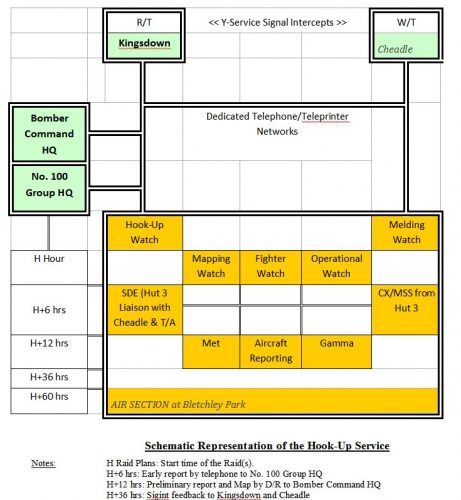
https://www.quora.com/Which-is-better-the-P-47-or-P-51D
Oops. Autopost before I even commented….
Anyways, been a while since I compared P47 vs P51. I remember being surprised about their compared performances. The Big Week posts inspired me to look again. Turns out, in addition to fine comments already made by Trent and others, that the expendable/attrition thread plays out, I suspect, in another way than what was thus far mentioned.
Briefly (cf link in above comment for details), P47 could do (if augmented) essentially all P51 could and was better able to survive damage. But it required nearly twice the fuel and cost about twice as much per plane. Thus, even tho P47 probably better able to bring pilot back…. I’m guessing the goal became putting as many planes into the fight as possible. The P51 better enabled the goal of more fighters.
“James Stewart looked up at his scarred Liberator bomber and said to one of his crew: “Sergeant, somebody could get hurt in one of those damned things”
—From BBS History Magazine on Big Week, Vol 19, No 13
tactics that allowed U.S. fighters to break from close escort and attack enemy planes before they could get to the bombers,
This was the point of the comment I made yesterday. Close escort did not work.
My cousin, who flew 50 missions in a B 17 out of North Africa (15th AF) told me their escorts were “P 38s and Me109s.”
Thanks for all the work you put in.
I would recommend “America’s One Hundred Thousand” by Francis H. Dean. This is loaded
with diagrams and technical detail on our nain fighter types. This is a real informational feast.
Roy Kerns,
Zemke and his fellow VIIITH Fighter Command mutineers were a center of tactical and technical innovation to rival anything that General Kenney and Paul Irving “Pappy” Gunn had in Australia.
See:
https://www.ozatwar.com/ozatwar/pappygunn.htm
It wasn’t just the “Super Thunderbolts.”
The UK built paper 75 gallon and 108/110 gallon drop tanks and the UK built flat 150 gallon and 200 gallon metal drop tanks were all in the tight loop between the 56th fighter Group and VIIIth Fighter Command’s Service and Technical sections.
And the Zemke tactics of a three way 180 degree split that was a part of the “Zemke Fan” was an anti-German fighter control countermeasure. It took about 5 minutes for a sharp fighter controller to pick up on the split and send information to his fighters.
Zemke’s inclusion of that split mean he was delaying German fighter controller warnings to the German twin-engine fighters he was hunting.
The Japanese Kamikaze Corps used similar “split” tactics to confuse US Navy fighter controllers during the Okinawa campaign with a great deal of success.